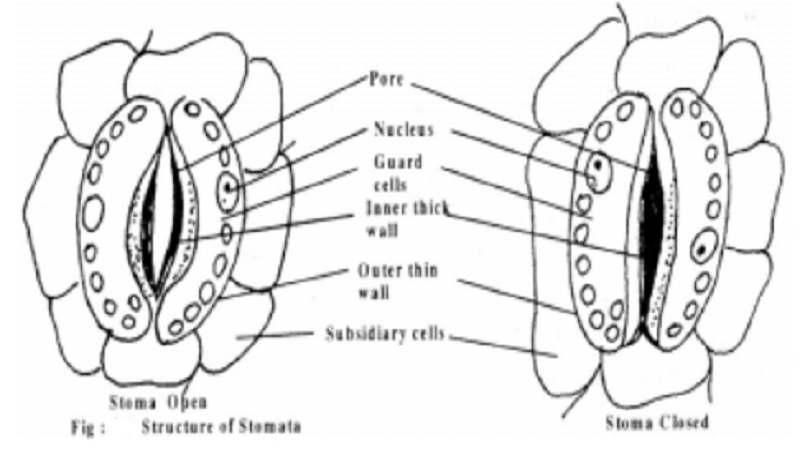Chapter: 11 th 12th std standard Bio Botany plant tree Biology Higher secondary school College Notes
Structure of Stoma and Mechanism of Stomatal Opening and Closing

Structure of Stoma
A stoma is a minute pore on the epidermis of aerial parts of plants through which exchange of gases and transpiration takes place.
Each stoma is surrounded by a pair of kidney shaped guard cells. Each guard cell is a modified epidermal cell showing a prominent nucleus, cytoplasm and plastids. The wall of the guard cell is differentially thickened. The inner wall of each guard cell facing the stoma is concave and is thick and rigid. The outer wall is convex and is thin and elastic.
The guard cells are surrounded by a variable number of epidermal cells called subsidiary cells.
Mechanism of Stomatal Opening and Closing
Opening and closing of stomata takes place due to changes in turgor of guard cells. Generally stomata are open during the day and close at night.
The turgor changes in the guard cells are due to entry and exit of water into and out of the guard cells. During the day, water from subsidiary cells enters the guard cells making the guard cells fully turgid. As a result, the thin elastic convex outer walls are bulged out causing the thick and rigid concave inner walls to curve away from each other causing the stoma to open.
During night time, water from guard cells enters the subsidiary cells and as a result, the guard cells become flaccid due to decrease in turgor pressure. This causes the inner concave walls to straighten up and the stoma closes.
The actual mechanism responsible for entry and exit of water to and from the guard cells has been explained by several theories.
The most important theories are
i. The starch-sugar interconversion theory of Steward
ii. Active K+ transport of Raschke
i. The Starch - Sugar interconversion Theory
Steward (1964) holds that during the day the enzyme phosphorylase converts starch to sugar, thus increasing osmotic potential of guard cells causing entry of water. The reverse reaction occurs at night bringing about closure.
Phosphorylase (day)
Starch (stoma opens) Sugar -> night -> (stoma closes)
ii. Proton - Potassium Pump Hypothesis
Levit in 1974 combined the points in Scarth's and Steward's hypothesis and gave a modified version of the mechanism of stomatal movement which was called the proton - potassium pump hypothesis.
According to this hypothesis K+ ions are transported into the guard cells in the presence of light. The sequence of events taking place are
i. Under the influence of light, protons formed by dissociation of malic acid move from cytoplasm in to the chloroplasts of guard cells.
ii. To counter the exit of protons, K+ ions enter the guard cells from the surrounding mesophyll cells.
iii. K+ ions react with the malate ions present in the guard cells to form potassium malate.
iv. Potassium malate causes increase in the osmotic potential of guard cells causing entry of water into the guard cells as a result of which the stoma opens.
v. At night the dissociation of potassium malate takes place and K+ ions exit out of guard cells causing loss of water from guard cells and so the stoma closes
Noggle and Fritz (1976) supported this theory and gave a scheme for opening of stomata.
Light
�
Starch
�
Production of Malic acid
�
Dissociation into H+ and Malate
�
Exit of H+ and entry of K+ ions
�
Formation of Potassium malate
�
Increase of OP of guard cells
�
Entry of water into guard cells
�
Increase in turgor of guard cells
�
Stoma opens
This theory is the widely accepted one as Levitt was able to demonstrate rise in K+ ion level during the day and the formation of organic acids like malic acid with the unused CO2 present in the guard cells.
Related Topics